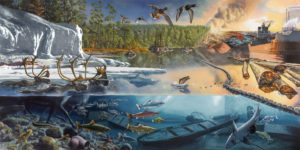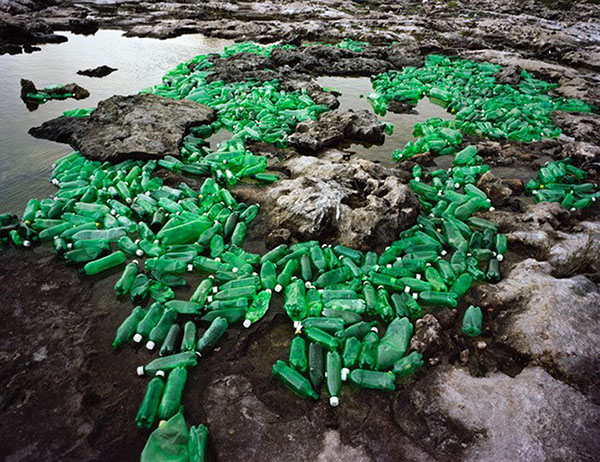Climate Art Beat℠
Fall/Winter Calendar 2019

New York Hall of Science and Design I/O, Connected Worlds (detail)(2015). Immersive digital art installation. Dimensions: 38’ x 2,300 sq. ft. © 2015 New York Hall of Science. Photo courtesy of NY Hall of Science.
We are pleased to highlight these 10 pioneering climate art events.
Chicago, IL

James Balog, Blue Ponds Formed by Meltwater in Alaska’s Columbia Glacier (left) and Meltwater River Formed by Glacier Melt in Greenland (right). Photographs. ©2014 James Balog/Extreme Ice Survey. Courtesy of the artist and Museum of Science and Industry.
Museum of Science and Industry
Extreme Ice captures the immediacy of climate change with James Balog’s visually stunning photographs and time-lapse videography of melting glaciers. To illustrate the physical and technological challenges Balog and his team had to overcome to gather this compelling footage, the exhibition displays their customized camera, expedition equipment, and a touchable 7-foot tall ice wall.
Now to Nov., 2020
Queens, NY

New York Hall of Science and Design I/O, Connected Worlds (detail)(2015). Immersive digital art installation. Dimensions: 38’ x 2,300 sq. ft. © 2015 New York Hall of Science. Photo courtesy of NY Hall of Science.
New York Hall of Science
Connected Worlds, a pioneering digital art exhibition, immerses visitors in a playful, animated, interactive world. Visitors’ gestures, motions and decisions affect how well systems in interconnected environments are kept in balance and illustrate how individual and collective actions impact sustainability.
Permanent Installation
Minneapolis, MN

Alexis Rockman, Cascade (2015). Oil and alkyd on wood panel. Dimensions: 72” x 144”. Collection: Grand Rapids Art Museum, 2015.19. © 2015, Alexis Rockman. Courtesy of the artist.
Weisman Art Museum, University of Minnesota
The Great Lakes Cycle, a solo exhibition of Alexis Rockman’s monumental paintings, watercolors, and field drawings, explores the past, present and future of the Great Lakes and the challenges they face from climate change and human pollution. Related events include an artist’s talk (Nov. 6, 7:00-9:00 pm) and an opportunity to work alongside the artist, creating original art with found material (Nov. 8, 1:00-3:00 pm).
Now to Jan. 5, 2020
Washington, DC

Judy Chicago, Stranded, from The End: A Meditation on Death and Extinction, 2016. Kiln-fired glass paint on black glass, 12 x 18 in. Courtesy of the artist; Salon 94, New York; and Jessica Silverman Gallery, San Francisco. ©Judy Chicago/Artists Rights Society (ARS), New York. Photo ©Donald Woodman/ARS, NY.
National Museum of Women in the Arts
In The End: A Meditation on Death and Extinction, Judy Chicago contemplates her own mortality and, moved by that reflection, laments the loss of animals, plants and ecosystems irreparably harmed by humans. Fifteen luminously painted glass panels call attention to embattled species, including stranded polar bears, bleached corals, silenced birds, and declining frog populations.
Now through Jan. 20, 2020
Bethlehem, PA

The Toxic Reef at the Smithsonian’s National Museum of Natural History, Washington, D.C., 2011. Photo courtesy of Lehigh University.
Lehigh University Zoellner Art Center
Drawing on art, science, geometry and environmental activism, Crochet Coral Reef: By Margaret and Christine Wertheim and the Institute for Figuring, is an evolving archipelago of crocheted wool installations emulating natural coral reef structures. The Reef calls attention to global warming’s devastating impact on coral reefs and has spawned satellite reefs across the globe. Visitors to the Lehigh exhibition can experiment with hands-on crochet and contribute to the Lehigh University Satellite Reef.
Now through Dec. 8, 2019
New York, NY

Michael Strano, MIT Chemical Engineering, and Sheila Kennedy, MIT Architecture, Massachusetts Institute of Technology and KVA Studio (United States), Nanobionic Plant Project: Ambient Illumination (2016-ongoing). Nanobionic watercress plants. Dimensions variable. Courtesy of MIT Professor S. Kennedy & Professor M. Strano Research Groups. ©Cooper Hewitt Press Images.
Cooper Hewitt Museum
Nature By Design features more than 60 groundbreaking works from designers collaborating with scientists, engineers, farmers, environmentalists, and nature itself to devise creative solutions to the crisis of human-caused climate change.
Now through Jan. 20, 2020
Philadelphia, PA

Diane Burko, On the Crevasse (2014). Archival pigment print. Dimensions: 60”x 40.” © Burko 2014. Courtesy of the artist.
American Swedish Historical Museum
Nordic Changes features 14 photographs and paintings by the internationally renowned artist, Diane Burko. Her artworks highlight the Arctic’s austere natural beauty and reveal how the Arctic is being dramatically transformed by climate change. Related events include “Date With Paint” sessions (Nov. 22 and Jan. 3, 7:00pm) where visitors can draw inspiration from Nordic Changes to paint their own Arctic scene.
Now through Jan. 5, 2020
Long Island, NY

Alejandro Durán, Algas (Algae) from the Washed Up series, 2013. Photograph, 40 x 52 in. Courtesy of the artist. ©2019 Alejandro Durán
Emily Lowe Gallery, Hofstra University Museum of Art
Environmental Impact features the work of nine artists, including Diane Burko, Edward Burtynsky, Alexis Rockman, and Alejandro Durán, who depict the dire consequences of human intrusion into the natural world. Related events include a roundtable discussing environmental issues (Nov. 13, 4:30-6:00 pm) and Family Fun ARTful adventures (Nov. 9 and Dec. 14, 11:30 am – 1:00 pm).
Now through Dec. 13, 2019
Hudson Valley, NY

Jean Shin, Process documentation for Allee Gathering (2019). Recycled maple wood and steel. Dimensions variable. © Jean Shin 2019. Photo courtesy of the artist.
Storm King Art Center
Jean Shin’s monumental picnic table, titled Allee Gathering, preserves the memory of 24 declining maple trees, which were replaced with trees better able to withstand changes in local climate and ground conditions. Shin’s table creates a communal place to rest, observe, reflect and converse and calls attention to the importance of tree health and land conservation in a changing climate. Also on display (until Nov. 11) are Mark Dion’s signature architectural Follies, compact structures exploring the intersections among art, nature, and culture.
Now to Nov. 24, 2019
Boston, MA

Olafur Eliasson, Northwest Passage (2018). Stainless steel, LED lights, diffusers. Dimensions: approximately 90 ft. long. Commissioned by Massachusetts Institute of Technology. Photograph by Anton Grassi ©Olafur Eliasson.
Massachusetts Institute of Technology, MIT.nano Building
Olafur Eliasson’s Northwest Passage references the sea route opening across the Arctic as ice coverage dwindles. Eliasson’s polished stainless steel panels evoke free-floating sea ice. As the ice melts, passage becomes easier, encouraging shipping which, in turn, burns fossil fuels, melting more ice. An optical illusion invites closer observation of this paradox: the installation’s semi-circular light rings, mirrored in steel, seem fully circular as the viewer changes position, a wry comment on our fleeting attention to climate change.
Permanent Installation
